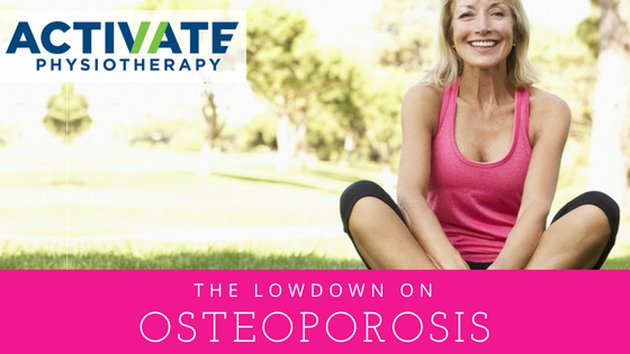Osteoporosis and low bone density (osteopenia) is one of the most prevalent diseases in Australia estimated to affect over 30% of the overall population with increase rates in those over 50years of age, particularly women.
What is osteoporosis?
Osteoporosis is a disease makes that causes your bones to become brittle leading to a higher risk of fractures than in normal bone. It causes your bones to lose calcium and other minerals faster than the body can replace them, causing a loss of bone density or thickness which causes them to lose strength.
Once the bones lose density even a minor bump or simply performing your usual daily activities can cause a serious fracture. A ‘fracture’ is a complete or partial break in a bone. Any bone can be affected by osteoporosis, but the most common sites are the hip and wrist from falls and fractures in the spine which can result in height loss or changes in posture.
How do I know if I am at risk of osteoporosis?
Osteoporosis is often called a ‘silent disease’ as there are generally no symptoms until a fracture occurs. In some cases osteoporosis can be prevented by looking after your bone health and being aware of the risk factors such as:
Age >50years: Like many tissues in the body, as we age the ratio of bone break down exceeds the rate of bone build up. This is largely due to changes in hormone levels that occur around the age of 50years
Menopause: As mentioned above changing hormone levels as we age contribute to losses in bone density. Women are at a greater risk of developing osteoporosis because of the rapid decline in oestrogen levels during menopause. When oestrogen levels decrease, bones lose calcium and other minerals at a much faster rate. As a result a bone loss of approximately 2% per year occurs for several years after menopause.
Even though men (arguably) dont go through menopause they aren’t risk free. However testosterone changes in men decline more gradually with age so their bone mass remains adequate till later in life.
Family History: People with a family history of osteoporosis or osteopenia are more likely to develop brittle bones themselves. If your parents or siblings have had a fracture from a minor fall or had height loss or posture changes you may be at greater risk too.
Low Calcium or Vitamin D Levels: If you’ve had a blood test and been told your calcium is low you are at risk of osteoporosis. Adults need an intake of adults require 1,000 mg per day (preferably through diet) which increases to 1,300 mg per day for women over 50 and men over 70 – so get that dairy in.
Vitamin D is important to assist your body to absorb calcium. Low vitamin D can be caused by a lack of sun exposure a lack of sun exposure, which due to our sun-smart behaviors and indoor, sedentary lifestyle is becoming an increasing issue.
Medical History and Medications: Some health conditions and medications also contribute to lowering bone density.
- Corticosteroids – commonly used for asthma, rheumatoid arthritis and other inflammatory conditions
- Low hormone levels – in women: early menopause; in men: low testosterone
- Thyroid conditions – over active thyroid or parathyroid
- Conditions leading to malabsorption eg: coeliac disease, inflammatory bowel disease
- Some chronic diseases eg: rheumatoid arthritis, chronic liver or kidney disease
- Some medicines for breast cancer, prostate cancer, epilepsy and some antidepressants
Obviously, it is important to be compliant with any treatment for these health conditions so bone health is just something to be mindful of if you suffer from any of the conditions above so you can ensure you do everything else possible to maintain your bone strength.
Modifiable Lifestyle Factors: These are factors you can certainly do something about to ensure optimal bone health. Lifestyle factors that increase osteoporosis risk include:
- Low levels of physical activity
- Smoking
- Excessive alcohol intake
- Weight – thin body build or excessive weight (recent studies suggest that hormones associated with obesity may impact bones)
I think I’m at risk how what do I do?
As mentioned earlier osteoporosis is a ‘silent disease’ and many people arent aware there is a problem until their first fracture. The sooner you find out you have osteoporosis the better. You can start to do something about it before you suffer a fracture. We know the risk of future fractures rises with each new fracture – it’s something known as the ‘cascade effect’. For example: women who have suffered a fracture in their spine are over 4 times more likely to have another fracture within the next year.
If you think you have a risk of osteoporosis the first step is to consult with your GP who will assess your risk and may send you for blood tests and a bone density scan.
A bone density scan is the gold standard test for osteoporosis. It is non-invasive and involves imaging of your bones to determine their density or thickness.
How is osteoporosis treated?

If your scans show lowered bone density or osteoporosis your GP may prescribe medications to slow the loss of bone as well as assisting you to make sure your levels of calcium and vitamin D are adequate. Exercise can also assist to slow bone loss and stimulate your bones to become stronger.
There are specific types of exercise that are best for your bones without placing them at risk of fracture, our team of Accredited Exercise Physiologists and Physiotherapists are experts at prescribing exercise for people with conditions such as osteoporosis. Click here to find out if we can help you or make a booking at our Gumdale or Stafford clinics online.
Osteoporosis Australia also provide great support and resources to help you understand and manage osteoporosis and bone density changes.

